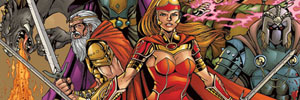#20 – Adrenaline Town Werewolves
Below are some myths dispelled in the Adrenaline Town series.
Myth Number One:
Werewolves are savage creatures with no rational thoughts. When they transform, they become animalistic and unable to stay in control of their urges.
False. In fact, werewolves conform to a system of order common to the animal kingdom called the pack system. The pack system is as follows; a leader is established (usually the oldest and strongest wolf) and the rest of the pack follows that wolfs lead. The leader can be challenged if one or many of the pack believe he has become incompetent, but usually the wolves don’t like to make waves in their packs, so they hesitate to take action unless things become drastic.
Werewolf packs consist of between seven and nine members. If a member of the pack loses control and begins to lash out and kill regular humans, then that member must be destroyed for the good of all packs. When you first become a werewolf, you are drawn to the pack closest to you by an incredible urge. In your first meeting with the pack, you will be taught of what you are and what you are capable of doing. After that you will be a member of the pack and you will remain with the pack you first meet, werewolves shun those who leave to join another pack or avoid their own kind.
Myth Number Two:
You must be bitten by a werewolf to become a werewolf. Werewolf genes can also be passed down through the family line, father to son and so on.
The truth is werewolf’s blood and saliva contains a special element that is virtually undetectable. In the rare occurrence (odds about sixteen million to one) that your bodies DNA structure accepts the element, your body will undergo a gestation period. Depending on the person, this period can take between six months and two years. After the gestation period, you will begin to feel your senses begin to heighten and change. You’ll want to tell people about the changes occurring, but you won’t be able to. You will begin to exhibit animalistic characteristics, little ones at first, but they will gradually increase.
Then, on a night of an eclipse of the moon, you will be drawn to a place you have never seen or thought of before. Guided by instinct, you will know the exact location and how to arrive at your destination. When you arrive, you’ll meet a small group of people who will be part of your pack and share a sort of unspoken bond with you.
Through research, there have been found some exceptions to the rules of changing into a werewolf. For example, if a small child’s DNA accepts the werewolf element, the gene will lay dormant until puberty. The hormones released during puberty will activate the gene and gestation will usually occur 2 to 3 years after puberty. There are never cases of children or young teenagers becoming werewolves.
Women rarely become werewolves because they have a special chromosome that fights against and 99% of the time kills the werewolf element. If a female werewolf and male werewolf have a child, the child will usually be a stronger, more powerful form of werewolf called a second-generation leader. He or she will, of course, not become a werewolf until after puberty, but when the change does occur, there is a great celebration called the Ratall. All of the packs in the surrounding areas come together to celebrate and welcome a second-generation wolf.
Unfortunately, the children of two werewolves rarely survive birth or past the age of five. They are plagued by illness throughout infancy and are sometimes killed by another pack out of jealousy. If a male or female werewolf has a child with an ordinary human, the child will be immune to the werewolf element and remain a normal human for its life.
Myth Number Three:
Only in the light of a full moon will a werewolf change. The person who is a werewolf has no control over the change. When not in werewolf form, the human is just an average person.
Unlike myths and movies, a real werewolf can change his/her form at anytime day or night. Rarely will a werewolf change during the day because they are less powerful and more likely to be seen. Werewolves pride themselves in their unknown status and will do anything to keep things that way. Since werewolves can change at any time, they must stay in control of their form and every situation at all times. When they are not in control, it drives them crazy. The control factor causes werewolves to avoid certain things.
The first is drinking alcohol at any time. Alcohol affects the amount of control they have over their form. When a werewolf does drink, it is usually with another member of his/her pack. That person provides company and will get them out of sight if or when they begin to lose control.
The second is anger. A werewolf must take on a peaceful nature because when you become angry you lose your rational thought. Without the rational thought process, control is easily lost. Being human, a werewolf will indeed become angry at time and lose control for a second, but they quickly realize what the consequences will be and regain control. Usually in anger situation, such as a fight, the werewolf will simply turn and walk or run away. The only time that is not true is when a werewolf is protecting something or someone it holds dear, because werewolves are taught from the beginning how important honor is. In the old days, the packs used to call each other “Original Samurai’sâ€. Even in these modern times, a wolf’s word is their bond.
A warning sign for werewolves that they are losing control are various facial ticks. These ticks are the first sign of losing control of their form because they are a sign of the transformation process. To be a werewolf today, you must realize the power you are capable of and Misuse of that power and lashing out or killing a regular human means to be destroyed by the pack.
Myth Number Four:
A werewolf is chaotic. They are naturally evil and enjoy causing or inflicting pain upon others.
The only ways werewolves can become evil, pain-inflicting creatures is, if they lose control when in wolf form or when someone is naturally evil and becomes a werewolf. When the latter occurs, the evil person usually ignores the laws of the pack, goes rogue and must be hunted and destroyed.
A werewolf retains the full capacity of his/her mind when they are in wolf form. Many have great senses of humor. During deer, moose, and elk hunting seasons, packs sometimes take retreats in the mountains seeing which wolf can scare the most hunters. The game is popular here in Utah.
Other interesting facts about modern werewolves:
• Werewolves have a high threshold for pain in human form and even higher in wolf form. When a werewolf is wounded, the wounds heal about five times faster when they are in wolf or wolfen form.
• Werewolves are three to five times stronger than regular humans, but their need for secrecy makes it so they will rarely, if ever show their full strength.
• In human form, werewolves cannot stand creatures doing violence to other creatures. They are strongly against humans hunting animals, but they don’t protest hunting for fear of drawing attention upon themselves. In their wolf form, however, their attitude becomes survival of the fittest in the animal kingdom. They take part in many hunting expeditions to keep their skills and senses at their peak.
• With their heightened senses, werewolves are very insightful about people. Their belief is that you should know more about a person than that person thinks you could ever know. Werewolves have the ability to identify a threatening person and avoid contact to keep out of a dangerous situation.










